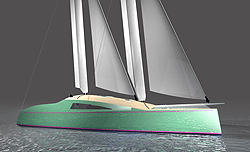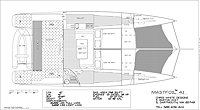I had been waiting for the opportunity to design a smaller, lighter, simpler catamaran for some time, and not long ago the 'right client' for that boat appeared. She has spent much of her life living aboard and cruising the Southeast USA, Bahamas and Caribbean. Her last boat, which she owned for a dozen years, was a 45' catamaran. After a few years ashore she started the quest for a new catamaran to fit her current needs.
 She had a wish list of course. The key items, tailored for her specific situation, were those that matter to many experienced cruising sailors - good looks, ease of handling, simplicity, and excellent performance both under sail and power.
She had a wish list of course. The key items, tailored for her specific situation, were those that matter to many experienced cruising sailors - good looks, ease of handling, simplicity, and excellent performance both under sail and power.
Good Looks
No question that a cruising boat of any size is a significant investment, and having one that's pleasing to the eye is important. A low and sleek profile is the look that we agreed on, while not compromising the seaworthiness that comes with all important high underwing clearance, sufficient freeboard, and robust construction.
Ease of handling
Like so many cruising sailors, this individual sails shorthanded. Easy single handed sailing is essential for her since her primary sailing companions are her two rather large standard poodles. Good company but lousy sailors.
The MastFoil rig offers unparalleled ease of handling. The soft sails (jibs) are simple and quick to unroll, reef or put away. There is no mainsail to hoist, reef or furl. The rig is self-tacking and all sail controls are led to the cockpit. The MastFoils provide significant drive to the sail plan and excellent performance when used alone in strong winds. In addition, there is great versatility in a two masted rig. Sail balance can be achieved on any point of sail by adjusting sail area fore and aft. At anchor, with the aft MastFoil locked on center, the boat will ride head to wind, eliminating the need to rig an anchor bridle.
Simple Accommodation
In order to keep the profile low, while preserving essential underwing clearance, the standing headroom of the MF41 is located in the hulls where it is most needed - in the galley, the head, and the hull adjacent to the double berths. The deckhouse consists primarily of the settee in the main cabin and double berths forward, where people are sitting or lying down most of the time. Therefore the deck house height can be reduced to the point where it does not obstruct forward visibility from the cockpit, making for safer and much more satisfying sailing.
 To make this configuration practical there are port and starboard doors from the cockpit into the deck house, so the traverse from standing in the cockpit to standing headroom in the hulls is only two steps.
To make this configuration practical there are port and starboard doors from the cockpit into the deck house, so the traverse from standing in the cockpit to standing headroom in the hulls is only two steps.
The principal concept for the interior layout is light and simple comfort for a small crew. There is a substantial galley in the port hull aft that has ample space for cooking and storage. Opposite the galley in the starboard hull is a full size head with shower and vanity. Forward in each hull are comfortable cabins, each with a queen sized berth and excellent ventilation. There is generous sitting head room in the berths and standing headroom in the hulls.
The hull forward of each double cabin can be configured in several ways. Boat #1 will utilize this area as a walk in closet with space for hanging some clothing and lockers for the rest. If more berths are needed one or both hull forepeaks can be configured with a single bunk. Otherwise it is great storage space for light sails, fenders, etc.
Between the hulls the main cabin settee area is spacious and comfortable. The large drop leaf table has room for six when both leaves are extended. Otherwise, with the table size reduced, the comfy seats provide a great place to sit with your feet propped up to watch a movie or read a book.
The cockpit is quite large and can be protected with a bimini that will provide complete protection from rain and spray.
Performance
Our experience to date with the MastFoil rig is that the windward sailing performance is about equal to a conventional sloop rig. This has recently been shown to be the case in a detailed CFD (Computational Fluid Dynamics) analysis done by Doyle CFD, a sub group of Doyle Sails. Numerical comparison of a conventional rig and MastFoil rig in the new Atlantic 47 catamaran indicated differences on the order of 1% - essentially no difference. Given the ease of handling and versatility of the MastFoil rig I gladly accept a moderate reduction in predicted aerodynamic performance. The ease of handling means the Mastfoil can be "dialed up and down" so quickly that the MastFoil is likely to be faster when actually sailing. This will be especially true when sailing shorthanded, where crew delays in responding to wind changes account for HUGE variation in performance. Make the rig easy to sail well and it will be sailed better.
Practical cruising boats need reliable power. While there is no particular reason to overpower a fast sail boat, having enough power to make good progress against wind and waves provides very desirable flexibility and safety. Twin 20 HP three cylinder engines will provide very efficient cruising speeds and great close quarters handling. Range under power with the normal tankage should be between 400 and 500 miles depending on the speed run. One side note here is that the MastFoils will be useful contributors to power performance as they can easily be trimmed to provide beneficial lift with the wind angle very far forward.
As all experienced multihull sailors know, a light boat is a fast boat. Building the boat with strong lightweight materials is the first step in reducing weight. Carbon fiber is used extensively in this design, resulting in lighter hull and deck laminates and better performance under both sail and power.
Of course the sailing performance of the best built boat in the world can be seriously compromised by careless choices of equipment and by overloading with superfluous gear and stores. The MF41 has less than half the overall displacement of many 40' "charterbarge" type cats and needs to be treated accordingly. She has ample payload capacity for safe and enjoyable cruising. The trick is to refrain from buying one of everything at the ship chandlery. Carry what you need, not everything that you imagine you might need 'someday'.
The MastFoil41 fills a large gap in the range of currently available multihulls. As a fast and fun club racer, weekend coastal cruiser or the occasional offshore passage maker to lands over the horizon the MF41 has lots of capability and addresses the way many people actually use their boats.
Besides that she's pretty cool looking too.
MastFoil™patented
copyright © 2009 Chris White Designs

